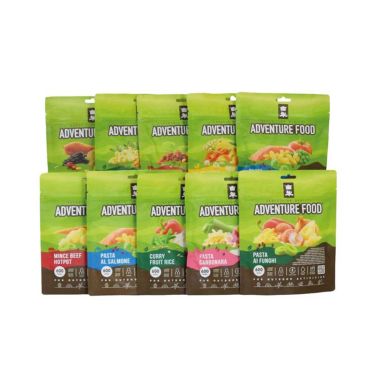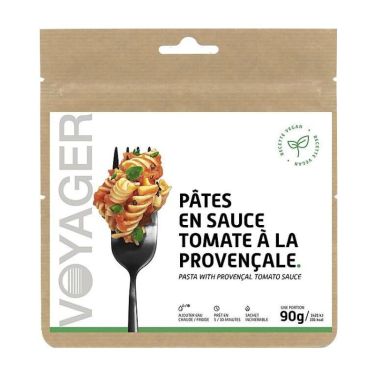-
Free delivery on purchases of €70 or more to relay points in Europe
-
Enjoy -10% on the Backpacking Food Category with the code: TREKKING10
Freeze-Dried Meals vs. Dehydrated Meals: What Are the Differences?
Freeze-dried and dehydrated meals are often mistaken for one another, but there are significant differences between these two preservation methods. Let’s explore them in this article.
In What Situations Is Rehydrated Food Used?
Rehydrated food, whether freeze-dried or dehydrated, is ideal for enjoying proper meals during activities like hiking, trekking, climbing, or participating in self-sufficient races such as the Marathon des Sables, or even sailing. These ultra-lightweight meals are essential for activities that require self-reliance over several days.
Rehydrated foods, especially freeze-dried ones, can also be conveniently stored at home for emergency situations (storms, power outages, supply chain disruptions in supermarkets...) thanks to their compactness and long shelf life.
In Europe, many manufacturers offer rehydrated meals. On lyophilise.fr, you can choose from hundreds of recipes. The selection is extensive—around 550 recipes—including breakfasts, main courses, desserts,staple foods, fruits, cheeses, vegetables, and more
How to Choose Rehydrated Meals?
Many questions arise before heading out on an expedition! From the number of calories to bring, the challenges you’ll face, the equipment you have, and the little luxuries you simply can’t live without, the weight of your backpack can quickly add up.
Depending on the adventure, freeze-dried or dehydrated meals may play a secondary role when fresh ingredients are available or can be combined with cooked meals. In these cases, they serve as emergency meals, and you’ll need to pay attention to calorie count. For instance, sailors often appreciate an extra hot meal that’s quick to prepare during their night shifts. Freeze-dried or dehydrated meals are perfect for such situations!
If the "all freeze-dried/dehydrated" option from breakfast to dessert is chosen (e.g., desert marathons, around-the-world sailing races), variety, taste, and recipe quality should be the key focus for a successful selection—always ensuring the right number of calories is packed.
The wide variety of freeze-dried and dehydrated recipes allows for selections tailored to individuals with dietary intolerances while also delighting everyone's taste buds.
Lastly, budget is an important factor to consider. As you’ll discover, there are many rehydrated meal recipes, but not all of them are freeze-dried. This impacts both the cost and the nutritional quality of the meals.
To help, we’ve put together a comparison of rehydrated meals based on their origin, packaging, preparation method, shelf life, calorie count, portion sizes, variety, and budget.
How to Choose Rehydrated Meals?
Many questions come up before embarking on an expedition! From determining the number of calories to pack, anticipating the challenges ahead, considering the equipment you have, and even accounting for those little luxuries you can’t bear to give up, the weight of your backpack can increase quickly.
Depending on the type of adventure, freeze-dried or dehydrated meals may play a secondary role if fresh ingredients are available or can be combined with cooked meals. In these cases, they serve as backup meals, and you’ll need to pay close attention to calorie count. For instance, sailors often appreciate an extra hot meal that’s quick to prepare during the night. Freeze-dried or dehydrated options are perfect for this scenario!
If you choose the "all freeze-dried/dehydrated" option, from breakfast to dessert (e.g., a desert marathon or an around-the-world sailing race), variety, taste, and recipe quality should be your guiding principles to ensure a successful selection while making sure you bring the right number of calories.
The wide range of freeze-dried and dehydrated recipes allows for selections tailored to individuals with dietary intolerances, while also delighting everyone’s taste buds.
Finally, budget is another factor to consider. As you’ll see, there are many rehydrated meal recipes, but not all of them are freeze-dried. This affects both the cost and the nutritional quality of the meals.
We’ve therefore decided to create a comparison of all rehydrated meal options based on their origin, packaging, preparation method, shelf life, calorie content, portion sizes, variety, and budget.
What Are the Different Types of Rehydrated Meals?
There are three types of rehydrated meals:
- 100% Freeze-Dried
- A Mix of Dehydrated and Freeze-Dried Ingredients
- 100% Dehydrated
Each manufacturing process offers its own advantages. Below, we explain the differences between these methods.
First Option: A 100% Freeze-Dried Meal
The producers listed below cook and freeze-dry their meals, meaning the ingredients are cooked together before being freeze-dried.
How Is Freeze-Drying Done?
- Meals are prepared and frozen to -40°C in a freeze-dryer.
- Air is removed from the freeze-dryer.
- The freeze-dryer is gradually warmed from -40°C to 0°C. During this process, the water in the food transitions directly from solid to gas without becoming liquid—a process known as sublimation.
Advantages of Freeze-Dried Meals:
- Higher caloric density per 100 g: Compared to dehydrated meals, freeze-dried options average around 450 kcal per 100 g.
- Rehydration with cold water is possible: If a heat source isn’t available, freeze-dried meals can be rehydrated with cold water. Note: cold water rehydration takes twice as long as boiling water.
- Long shelf life: Freeze-dried meals in pouches can be stored for 3 to 8 years, depending on the brand, while canned meals can last up to 25 years after the manufacturing date.
- Minimal additives or preservatives: Most recipes contain none, except for a few (e.g., those with eggs).
Hiking pack - 7 days - Freeze-dried food and snacks

Pulled pork and rice

Cheese and mushroom pasta

Pasta in tomato sauce Provençal style

Savoyard Tartiflette

Chicken kebab and rice

Freeze-dried meals are more expensive than dehydrated meals or those combining freeze-dried and dehydrated ingredients. This is because the larger the food item, the more time and energy it takes to freeze-dry. As a result, meat, fish, and poultry pieces are usually small to keep the process cost-effective.
Freeze-drying is of higher quality because it retains about 95% of the food’s nutritional value, whereas dehydration only preserves around 60%. This is because the heat used in dehydration destroys some vitamins and minerals.
Only the sauce in freeze-dried meals is powdered. Ingredients like starches, meats, and vegetables remain distinct and separate within the pouch.
Second Option: A 100% Dehydrated Meal
Dehydration, or drying with heat, is an ancient method of food preservation.
The process removes enough water (up to 94%) from the product to extend its shelf life while also significantly reducing its weight. Although it requires less energy than freeze-drying, the chemical reactions that occur during dehydration impact both the taste and nutritional quality of the food. Depending on the product, dehydration can result in a 10% to 50% loss of nutrients.
- Shelf Life: These meals last 2 to 3 years after the manufacturing date, shorter than freeze-dried alternatives.
- Cost-Effectiveness: Dehydration is far less expensive, as it only requires heating the food.
- Rehydration: Dehydrated meals must be rehydrated with hot water, unlike freeze-dried meals, which can also be rehydrated with cold water.
Third Option: A Mix of Freeze-Dried and Dehydrated Ingredients
Why Use This Approach?
Cooking an entire recipe at once doesn’t allow for large-scale production. To address this, manufacturers may dehydrate or freeze-dry individual ingredients in bulk to reduce production costs. The final recipe is created by combining these freeze-dried and dehydrated ingredients in a single pouch.
This method doesn’t necessarily result in poor quality. Less delicate ingredients, like starches, can be dehydrated and combined with higher-quality ingredients, such as freeze-dried meat.
Drawbacks of These Meals
- Rehydration with cold water isn’t possible due to the presence of dehydrated ingredients.
- The ingredients are not cooked together, meaning they haven’t simmered as a complete recipe. This can sometimes result in less flavor compared to a 100% freeze-dried meal.
Outdoor Meals to Suit Everyone's Needs
Today, brands are creating a variety of recipes to cater to individual needs and accommodate dietary restrictions. These meals are designed to delight food lovers, even those without specific dietary requirements:
There's something for every adventurer!
Customer Feedback: Do We Have a Favorite Brand?
We carefully select our manufacturers and suppliers for the quality of their meals and build trusting relationships with them. It's incredibly difficult for us to choose a single favorite brand. After all, preferences depend on individual tastes, budgets, and cultures. That’s precisely why we offer such a wide variety!
If you have feedback, an anecdote, or an opinion to share, feel free to tell us about your experience in the comments below.
A Word About Lyophilise & Co 🌶
Based in Lorient, Lyophilise & Co is the go-to reference for freeze-dried meals and high-quality outdoor gear. Whether you're a hiker, skipper, trail runner, bushcraft enthusiast, or bivouac lover, we offer a wide range of technical products tailored to all your adventures. With over 2,000 items available, we support your expeditions in France and abroad.
If you have any questions, our experts are here to help and will gladly assist you:
☎ +33 (0)2 97 87 23 73
✉ team[at]lyophilise.com
We also have a showroom open Monday to Friday:
📍 6 bis rue du Sous-Marin Vénus, 56100 Lorient, France
Related posts
-
 Food during the Marathon des Sables, by Carole Pipolo
We interviewed Carole Pipolo, founder of Outdoor And News and partner of Lyophilise & Co, to ask her about...Lire la suite
Food during the Marathon des Sables, by Carole Pipolo
We interviewed Carole Pipolo, founder of Outdoor And News and partner of Lyophilise & Co, to ask her about...Lire la suite -
 Sailing - What to Eat?
In this article, dive into the world of provisioning with freeze-dried recipes, along with their alternatives and...Lire la suite
Sailing - What to Eat?
In this article, dive into the world of provisioning with freeze-dried recipes, along with their alternatives and...Lire la suite -
 Special Volvo Ocean Race
Posted in: Food2024-11-15What sailors eat during the race!Lire la suite
Special Volvo Ocean Race
Posted in: Food2024-11-15What sailors eat during the race!Lire la suite -
 Special Vendée Globe - What Do Skippers Eat?
Posted in: Food2024-11-15For weeks, the skippers of the Vendée Globe have been meticulously preparing their onboard provisions, and we thank...Lire la suite
Special Vendée Globe - What Do Skippers Eat?
Posted in: Food2024-11-15For weeks, the skippers of the Vendée Globe have been meticulously preparing their onboard provisions, and we thank...Lire la suite -
 How to Prepare Your Nutrition for a Self-Supported Race Like the Marathon des Sables?
2024-11-15Wondering what food to choose and how to prepare your freeze-dried meals during the race? This article will provide...Lire la suite
How to Prepare Your Nutrition for a Self-Supported Race Like the Marathon des Sables?
2024-11-15Wondering what food to choose and how to prepare your freeze-dried meals during the race? This article will provide...Lire la suite















Leave a comment